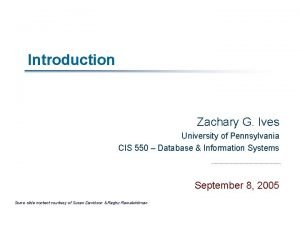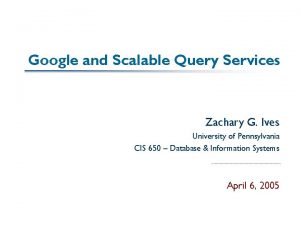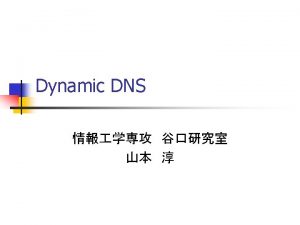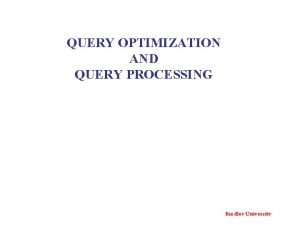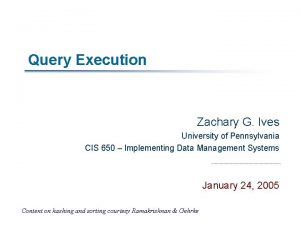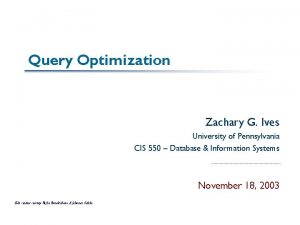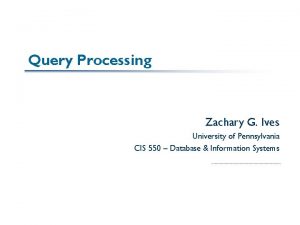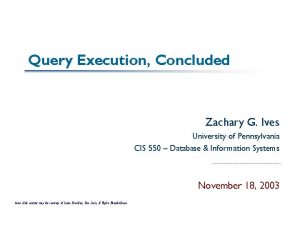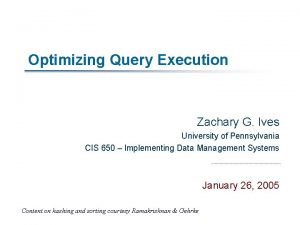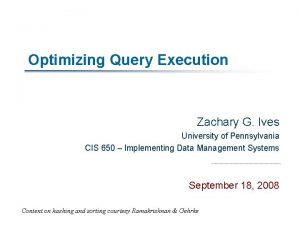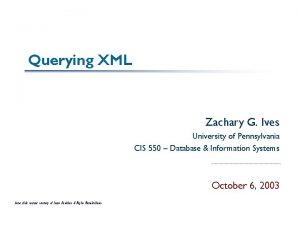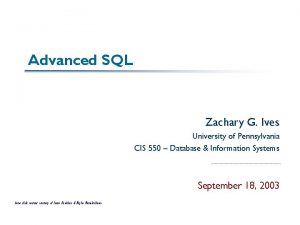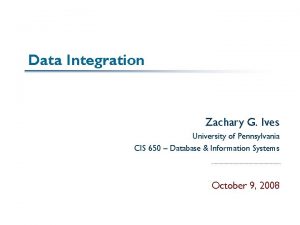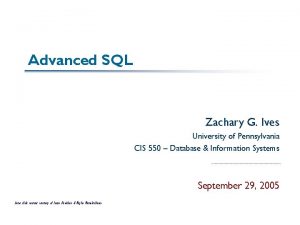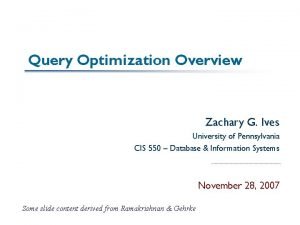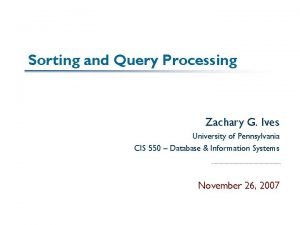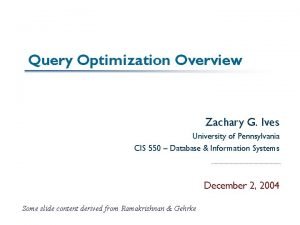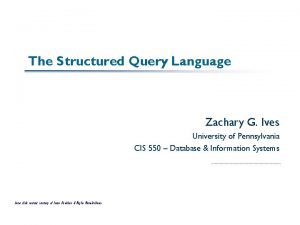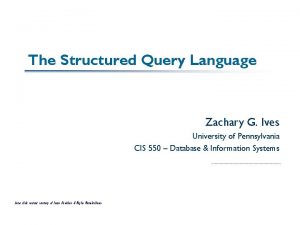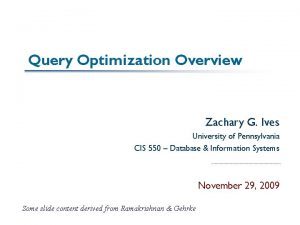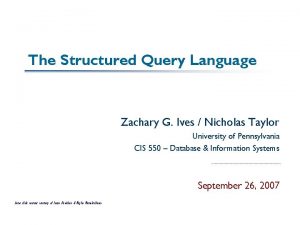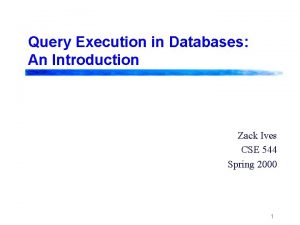Query Execution Zachary G Ives University of Pennsylvania





























- Slides: 29

Query Execution Zachary G. Ives University of Pennsylvania CIS 550 – Database & Information Systems November 23, 2004

Recap of Recent Discussions § We can choose different data layout formats for our tuples: § Heap files § Sorted files § Hashed files § In addition, we can duplicate a certain amount of data in order to speed up access – an index over a search key § Clustered index has data in same order (typically embedded) § Unclustered index has data in some other order § We saw the B+ tree, a balanced search tree with high fan-out 2

Making Use of the Data + Indices: Query Execution § § Query plans & exec strategies Basic principles Standard relational operators Querying XML 3

Query Plans § Data-flow graph of relational algebra operators § Typically: determined by optimizer Join Press. Rel. Symbol = East. Co. Symbol Join Project Press. Rel. Symbol = Clients. Symbol Co. Symbol Select SELECT * FROM Press. Rel p, Clients C WHERE p. Symbol = c. Symbol AND c. Client = ‘Atkins’ AND c. Symbol IN (SELECT Co. Symbol FROM East. Coast) Client = “Atkins” Scan Press. Rel Clients East. Coast 4

Iterator-Based Query Execution § Execution begins at root Join § open, next, close § Propagate calls to children Press. Rel. Symbol = East. Co. Symbol May call multiple child next s P Efficient scheduling & resource usage Join Project Press. Rel. Symbol = Clients. Symbol Co. Symbol Select Can you think of alternatives and their benefits? Client = “Atkins” Scan Press. Rel Clients East. Coast 5

Execution Strategy Issues Granularity & parallelism: § Pipelining vs. blocking § Materialization Join Press. Rel. Symbol = East. Co. Symbol Join Project Press. Rel. Symbol = Clients. Symbol Co. Symbol Select Client = “Atkins” Scan Press. Rel Clients East. Coast 6

Basic Principles § Many DB operations require reading tuples, tuple vs. previous tuples, or tuples vs. tuples in another table § Techniques generally used: § Iteration : for/while loop comparing with all tuples on disk § Index : if comparison of attribute that’s indexed, look up matches in index & return those § Sort/merge : iteration against presorted data (interesting orders ) § Hash: build hash table of the tuple list, probe the hash table Ø Must be able to support larger-than-memory data 7

Basic Operators § One-pass operators: § Scan § Select § Project § Multi-pass operators: § Join Various implementations Handling of larger-than-memory sources § Semi-join § Aggregation, union, etc. 8

1 -Pass Operators: Scanning a Table § Sequential scan: read through blocks of table § Index scan: retrieve tuples in index order § May require 1 seek per tuple! When? § Cost in page reads – b(T) blocks, r(T) tuples § b(T) pages for sequential scan § Up to r(T) for index scan if unclustered index § Requires memory for one block 9

1 -Pass Operators: Select (s) § Typically done while scanning a file § If unsorted & no index, check against predicate: Read tuple While tuple doesn’t meet predicate Read tuple Return tuple § Sorted data: can stop after particular value encountered § Indexed data: apply predicate to index, if possible § If predicate is: § conjunction: may use indexes and/or scanning loop above (may need to sort/hash to compute intersection) § disjunction: may use union of index results, or scanning loop 10

1 -Pass Operators: Project ( P) § Simple scanning method often used if no index: Read tuple While tuple exists Output specified attributes Read tuple § Duplicate removal may be necessary § Partition output into separate files by bucket, do duplicate removal on those § If have many duplicates, sorting may be better § If attributes belong to an index, don’t need to retrieve tuples! 11

Multi-pass Operators: Join (⋈) – Nested-Loops Join § Requires two nested loops: For each tuple in outer relation For each tuple in inner, compare If match on join attribute, output § § P P O Join outer inner Results have order of outer relation Can do over indices Very simple to implement, supports any joins predicates Supports any join predicates Cost: # comparisons = t(R) t(S) # disk accesses = b(R) + t(R) b(S) 12

Block Nested-Loops Join § Join a page (block) at a time from each table: For each page in outer relation For each page in inner, join both pages If match on join attribute, output P More efficient than previous approach: O Cost: # comparisons still = t(R) t(S) # disk accesses = b(R) + b(R) * b(S) 13

Index Nested-Loops Join For each tuple in outer relation For each match in inner’s index Retrieve inner tuple + output joined tuple § Cost: b(R) + t(R) * cost of matching in S § For each R tuple, costs of probing index are about: § 1. 2 for hash index, 2 -4 for B+-tree and: Clustered index: 1 I/O on average Unclustered index: Up to 1 I/O per S tuple 14

Two-Pass Algorithms Sort-based Need to do a multiway sort first (or have an index) Approximately linear in practice, 2 b(T) for table T Hash-based Store one relation in a hash table 15

(Sort-)Merge Join § Requires data sorted by join attributes Merge and join sorted files, reading sequentially a block at a time § Maintain two file pointers While tuple at R < tuple at S, advance R (and vice versa) While tuples match, output all possible pairings P P O § § Preserves sorted order of “outer” relation Very efficient for presorted data Can be “hybridized” with NL Join for range joins May require a sort before (adds cost + delay) Cost: b(R) + b(S) plus sort costs, if necessary In practice, approximately linear, 3 (b(R) + b(S)) 16

Hash-Based Joins § Allows partial pipelining of operations with equality comparisons § Sort-based operations block, but allow range and inequality comparisons § Hash joins usually done with static number of hash buckets § Generally have fairly long chains at each bucket § What happens when memory is too small? 17

Hash Join Read entire inner relation into hash table (join attributes as key) For each tuple from outer, look up in hash table & join P Very efficient, very good for databases O Not fully pipelined O Supports equijoins only O Delay-sensitive 18

Running out of Memory § Prevention: First partition the data by value into memorysized groups Partition both relations in the same way, write to files Recursively join the partitions § Resolution: Similar, but do when hash tables full Split hash table into files along bucket boundaries Partition remaining data in same way Recursively join partitions with diff. hash fn! § Hybrid hash join: flush “lazily” a few buckets at a time § Cost: <= 3 * (b(R) + b(S)) 19

Pipelined Hash Join Useful for Joining Web Sources § Two hash tables § As a tuple comes in, add to the appropriate side & join with opposite table P Fully pipelined, adaptive to source data rates P Can handle overflow as with hash join O Needs more memory 20

Aggregation )( § Need to store entire table, coalesce groups with matching GROUP BY attributes § Compute aggregate function over group: § If groups are sorted or indexed, can iterate: Read tuples while attributes match, compute aggregate At end of each group, output result § Hash approach: Group together in hash table (leave space for agg values!) Compute aggregates incrementally or at end At end, return answers § Cost: b(t) pages. How much memory? 21

Other Operators § Duplicate removal very similar to grouping § All attributes must match § No aggregate § Union, difference, intersection: § Read table R, build hash/search tree § Read table S, add/discard tuples as required § Cost: b(R) + b(S) 22

SQL Operations In a whirlwind, you’ve seen most of relational operators: § § Select, Project, Join Group/aggregate Union, Difference, Intersection Others are used sometimes: Various methods of “for all, ” “not exists, ” etc Recursive queries/fixpoint operator etc. 23

What about. XQuery? § Major difference: bind variables to subtrees; treat each set of bindings as a tuple § Select, project, join, etc. on tuples of bindings § Plus we need some new operators: § XML construction: Create element (add tags around data) Add attribute(s) to element (similar to join) Nest element under other element (similar to join) § Path expression evaluation – create the binding tuples 24

Standard Method: XML Query Processing in Action Parse XML: <db> <store> <manager>Griffith</manager> <manager>Sims</manager> <location> <address>12 Pike Pl. </address> <city>Seattle</city> </location> </store> … Match paths: $s = (root)/db/store $m = $s/manager/data() $c = $s//city/data() $s #1 #1 #2 $m Griffith Sims Jones $c Seattle Madison 25

X-Scan: “Scan” for Streaming XML, Based on SAX § We often re-read XML from net on every query Data integration, data exchange, reading from Web § Could use an XML DBMS, which looks like an RDBMS except for some small extensions § But cannot amortize storage costs for network data § X-scan works on streaming XML data § Read & parse § Evaluate path expressions to select nodes 26

X-Scan: Incremental Parsing & Path Matching db store <db> <store> #1 <manager>Griffith</manager> manager data() <manager>Sims</manager> $m 4 5 6 <location> <address>12 Pike Pl. </address> $c city data() 6 7 8 <city>Seattle</city> </location> </store> Tuples for query: <store> #2 <manager>Jones</manager> $s $m $c <address>30 Main St. </address> #1 Griffith Seattle <city>Berkeley</city> #1 Sims Seattle </store> #2 Jones Berkeley </db> $s 1 2 3 27

What Else Is Special in XQuery? § Support for arbitrary recursive functions § Construction of XML tags § But we saw how that could be done using “outer union” previously, and we can use similar approaches here 28

Query Execution Is Still a Vibrant Research Topic § Adaptive scheduling of operations – combining with optimization (discussed next!) § Robust – exploit replicas, handle failures § Show and update partial /tentative results § More interactive and responsive to user § More complex data models – XML, semistructured data § Next week: how we actually pick which algorithms to use, and when – query optimization 29
 Zachary g. ives
Zachary g. ives Convert image to word
Convert image to word Iterative query vs recursive query
Iterative query vs recursive query Query tree and query graph
Query tree and query graph Query tree and query graph
Query tree and query graph Differential diagnosis for atopic dermatitis
Differential diagnosis for atopic dermatitis California university of pennsylvania global online
California university of pennsylvania global online Gentleman names
Gentleman names Jenny wismer
Jenny wismer St ives town council cornwall
St ives town council cornwall Language
Language Early modern english verb conjugation
Early modern english verb conjugation John brown the martyr currier and ives 1870
John brown the martyr currier and ives 1870 Gary ives bradford study
Gary ives bradford study Zachary rothschild
Zachary rothschild Flesh and blood so cheap
Flesh and blood so cheap Zachary omohundro
Zachary omohundro Zachary youth park field map
Zachary youth park field map Zachary ridgway
Zachary ridgway Zachary ho
Zachary ho Dr zachary sprague
Dr zachary sprague Zachary lytle
Zachary lytle Zachary ivey
Zachary ivey Zach hawkins actor
Zach hawkins actor Zachary schutzman
Zachary schutzman Zhu
Zhu Zachary jacobson
Zachary jacobson Zachary kurmas
Zachary kurmas Randy liang
Randy liang Harsch tenant portal
Harsch tenant portal
